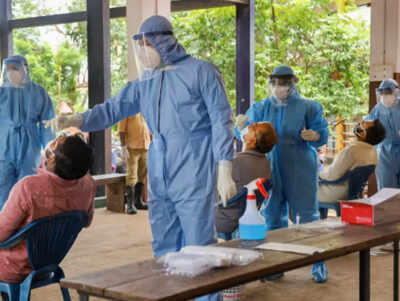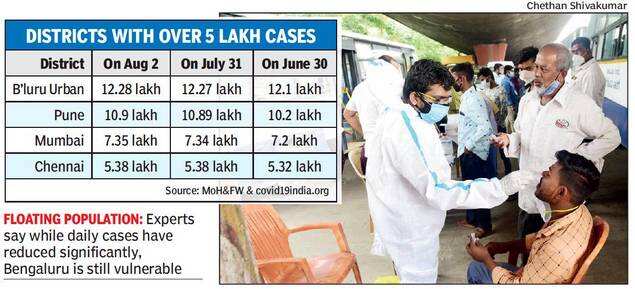Top Searches
- News
- City News
- bengaluru News
- Despite Covid cases plateauing, Bengaluru is still a concern
Despite Covid cases plateauing, Bengaluru is still a concern

Image used for representational purpose only
BENGALURU: The number of fresh Covid-19 cases daily in Bengaluru Urban district over the past couple of weeks has hovered around the 500-mark, and while it may be far fewer than the numbers recorded during the peak of the second wave, the situation continues to be a matter of concern for the state as the government prepares for a third wave.
Experts advising the government, and bureaucrats managing the pandemic say that while daily numbers have reduced significantly since May, the district continues to be vulnerable because of its population density and the fact that it’s an economic powerhouse, attracting people from across the country.

As of Tuesday, Bengaluru Urban had more than 12.2 lakh Covid-19 infections — 477 of them reported on the day — and 8,986 active cases. More than 64% (over 8.4 lakh) of the total cases in Bengaluru have been reported since April 2021.
Bengaluru, which pipped Pune — which currently has around 10.9 lakh cases — to become the district with the highest number of cases in the country in the middle of the second wave, continues to occupy the top spot despite Pune reporting more daily cases than Bengaluru consistently for the past month.
In fact, as on date, only nine states — Maharashtra (63.1 lakh), Kerala (34.2 lakh), Karnataka (29 lakh), Tamil Nadu (25.6 lakh), Andhra Pradesh (19.7 lakh), Uttar Pradesh (17 lakh), West Bengal (15.3 lakh), Delhi (14.3 lakh) and Chattisgarh (10 lakh) — have 10 lakh or more cases in India.
Comparatively, Bengaluru and Pune districts both have more than 9 lakh cases, and if the current trend holds, Karnataka’s capital might be the first district in the country to touch 10 lakh cases. That could happen before the end of this week.
P Ravi Kumar, chief secretary, told TOI: “Aside from existing measures, we’ve empowered the BBMP chief commissioner to even impose local lockdowns. If the administration finds any particular area to be problematic, it can impose these restrictions.”
Caught underprepared ahead of the second wave, BBMP has been reiterating the need for strict implementation of curbs to curtail fresh infections.
D Randeep, special commissioner (health), BBMP, said: “Last year, the plateau was around 150-200 cases and now it is around 400-500 cases, which is expected given that we are under unlock. While the state can impose a curfew or a lockdown at any time, the government has now also delegated powers to the chief commissioner who will in turn delegate the same to joint and zonal commissioners.”
As of Monday, there were 136 micro containment zones — homes, apartments, hostels, streets, etc — in Bengaluru. Randeep said the highest number of micro containment zones in July were 48.
“However, earlier, we declared a place a micro containment zone if there were 10 cases, now it’s just three, which is why there are more zones. This is because we are taking additional precautions to keep a check on the numbers,” Randeep said.
The BBMP has also been batting for stricter implementation of night curfew and other Covid- appropriate behaviour. Given the spike in cases in Kerala and Maharashtra, special restrictions are also being imposed on those travelling from those states, including separate teams at major bus stops and railway stations.
Experts advising the government, and bureaucrats managing the pandemic say that while daily numbers have reduced significantly since May, the district continues to be vulnerable because of its population density and the fact that it’s an economic powerhouse, attracting people from across the country.

As of Tuesday, Bengaluru Urban had more than 12.2 lakh Covid-19 infections — 477 of them reported on the day — and 8,986 active cases. More than 64% (over 8.4 lakh) of the total cases in Bengaluru have been reported since April 2021.
Bengaluru, which pipped Pune — which currently has around 10.9 lakh cases — to become the district with the highest number of cases in the country in the middle of the second wave, continues to occupy the top spot despite Pune reporting more daily cases than Bengaluru consistently for the past month.
In fact, as on date, only nine states — Maharashtra (63.1 lakh), Kerala (34.2 lakh), Karnataka (29 lakh), Tamil Nadu (25.6 lakh), Andhra Pradesh (19.7 lakh), Uttar Pradesh (17 lakh), West Bengal (15.3 lakh), Delhi (14.3 lakh) and Chattisgarh (10 lakh) — have 10 lakh or more cases in India.
Comparatively, Bengaluru and Pune districts both have more than 9 lakh cases, and if the current trend holds, Karnataka’s capital might be the first district in the country to touch 10 lakh cases. That could happen before the end of this week.
P Ravi Kumar, chief secretary, told TOI: “Aside from existing measures, we’ve empowered the BBMP chief commissioner to even impose local lockdowns. If the administration finds any particular area to be problematic, it can impose these restrictions.”
Caught underprepared ahead of the second wave, BBMP has been reiterating the need for strict implementation of curbs to curtail fresh infections.
D Randeep, special commissioner (health), BBMP, said: “Last year, the plateau was around 150-200 cases and now it is around 400-500 cases, which is expected given that we are under unlock. While the state can impose a curfew or a lockdown at any time, the government has now also delegated powers to the chief commissioner who will in turn delegate the same to joint and zonal commissioners.”
As of Monday, there were 136 micro containment zones — homes, apartments, hostels, streets, etc — in Bengaluru. Randeep said the highest number of micro containment zones in July were 48.
“However, earlier, we declared a place a micro containment zone if there were 10 cases, now it’s just three, which is why there are more zones. This is because we are taking additional precautions to keep a check on the numbers,” Randeep said.
The BBMP has also been batting for stricter implementation of night curfew and other Covid- appropriate behaviour. Given the spike in cases in Kerala and Maharashtra, special restrictions are also being imposed on those travelling from those states, including separate teams at major bus stops and railway stations.
FacebookTwitterLinkedinEMail
Start a Conversation
end of article

